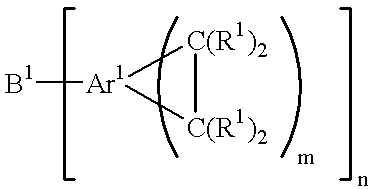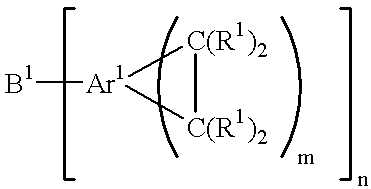Acid functional polymers based on benzocyclobutene
- Summary
- Abstract
- Description
- Claims
- Application Information
AI Technical Summary
Benefits of technology
Problems solved by technology
Method used
Image
Examples
example 1
Preparation of 2-Propenoic acid, 3-bicyclo[4.2.0]octa-1,3,5 trien-3-yl (hereinafter referred to as BCB-acrylic acid)
Brominated benzocylcobutene (Br-BCB) was reacted with acrylic acid (AA) to form BCB-acrylic acid: ##STR10##
Specifically, a five-liter thermowell three-neck flask with a PTFE bottom drain was equipped with a PTFE stirrer bearing, an overhead electric agitator, a thermocouple-controlled heating mantle with a timer and a high-temperature shutoff, a nitrogen inlet atop a condenser leading to an oil bubbler, and a glass funnel. All joints were sealed with PTFE sleeves, and the flask was covered (above the mantle) with fiberglass insulation. The catalysts--1.01 grams of palladium acetate and 4.721 grams of triphenylphosphine--were weighed into a small nitrogen-flushed jar and magnetically stirred with about 100 grams of dimethylformamide (DMF) at room temperature (with the cap on). The flask was purged with nitrogen, charged with triethylamine, water, BrBCB, AA, and DMF (usi...
example 2
Preparation and Positive Photoimaging of a Curable Polymer having a 25:75 Mole Ratio of DVS-bisBCB:BCB-acrylic Acid (about 228 grams / mole of acid functionality)
a) MW of 3900 g / mole
DVS-bisBCB (26.81 g, 0.0687 mol) (as made, for example, in Procedure A of WO 94 / 25903), BCB acrylic acid (35.88 g, 0.206 mol) and 190 g Dowanol DPMA were added to a 3-necked flask equipped with a mechanical stirrer, a nitrogen inlet and a condenser. The mixture was heated under nitrogen at 160.degree. C. for 50 hours.
The solution of DVS-bisBCB / BCB-AA oligomer (14.70 g, 29.2% solids, 4.292 g solids, Mw=3,900 g / mol) was mixed with 0.8462 g (16.5%) trihydroxybenzophenone diazo naphthol sulfonate ester (THBP). An adhesion promoter (hydrolyzed vinyl triacetate silane, referred to as VTAS) was applied to a wafer at 2000 rotations per minute (rpm). The solution was then spread on a 4 inch silicon wafer at 500 rpm (10 seconds) followed by spin-coating at 1500 rpm for 30 seconds. The wafer was baked on a hot plate ...
example 3
Preparation and Positive Photoimaging of a Curable Polymer having a 40:60 Mole Ratio of DVS-bisBCB:BCB-acrylic Acid (about 260 g / mole of acid functionality)
a) MW of 4300 g / mole
DVS-bisBCB (48.8 g, 0.125 mole), BCB acrylic acid (32.6 g, 0.188 mole) and 100 g Dowanol DPMA were heated with stirring under nitrogen until weight average molecular weight of 4,300 g / mole was reached. Some solvent was added to have solid contents of 34%. At this point, solution viscosity was 1237 cP at 25.degree. C.
A 27.2 g solution was mixed with 1.82 g THBP (16.5%) and the solution was filtered with a 5 micron syringe filter. A patterned film on the silicon wafers was generated as follows: An adhesion promoter was applied to a 4 inch diameter silicon wafer at 2000 rpm. The solution was spread at 500 rpm for 10 seconds followed by spin-coating at 1500 rpm for 30 seconds. The wafer was baked on a hot-plate at 95.degree. C. for 4 minutes and exposed through a mask with a Karl Suss exposure tool at 250 mJ / cm.su...
PUM
| Property | Measurement | Unit |
|---|---|---|
| Molar mass | aaaaa | aaaaa |
| Molar mass | aaaaa | aaaaa |
| Molar mass | aaaaa | aaaaa |
Abstract
Description
Claims
Application Information
 Login to View More
Login to View More - R&D
- Intellectual Property
- Life Sciences
- Materials
- Tech Scout
- Unparalleled Data Quality
- Higher Quality Content
- 60% Fewer Hallucinations
Browse by: Latest US Patents, China's latest patents, Technical Efficacy Thesaurus, Application Domain, Technology Topic, Popular Technical Reports.
© 2025 PatSnap. All rights reserved.Legal|Privacy policy|Modern Slavery Act Transparency Statement|Sitemap|About US| Contact US: help@patsnap.com



